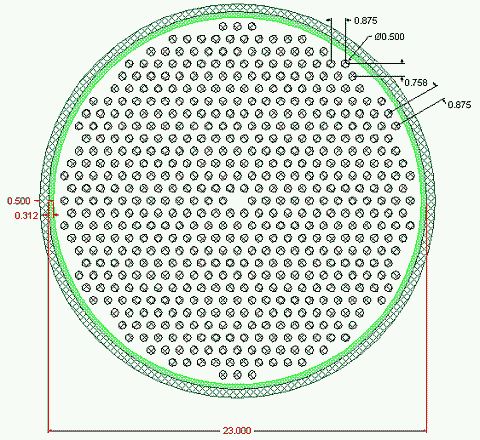|
Boiler Construction Drawing Stanley provided 14" high boilers in their cars starting with the 735 in 1918. When they went to the 740s in 1922 the boilers jumped to 18" height. All were the standard 20-horsepower diameter of 23". They used a 16" in their mountain wagons. My Stanley had a 14" boiler in it when I bought it and after it developed a number of leaking flues before I got to 400 PSIG I decided to replace it. When I asked Tom Marshall's advice (my mentor through all my Stanley activities) he suggested not going to an 18" boiler as I was thinking but rather a 16" would be better. He felt the 14" boilers never had much reserve steam capacity and that the 18" boilers took far too long to steam up and were sluggish on the road steaming. Tom's father, Clarence, had always preferred the 16" as ideal. That pretty much made up my mind. Thus my replacement boiler would be a 23" diameter by 16" high welded flue boiler along the lines of construction that Stanley provided. A computer-aided design (CAD) drawing was generated for the new boiler. It specified the pattern of 1/2-inch holes to be drilled in the flue sheets for the 636 flues that would be installed. It also provided design information for the rolling of the boiler’s shell and the welding of the various parts into the finished boiler. The drawing above shows the top of the boiler and the drilling pattern for the flues. Stanley boilers have a lifespan of 10,000 to 25,000 miles depending on the quality of the water available, the attention the owner pays to proper operation of the car, and a host of other factors. There are several individuals who manufacture Stanley boilers for Stanley owners however these boilers are generally for non-condensing cars. Non-condensing car boilers have copper flues and each flue is swaged to the flue sheet using a small steel ferrule. Stanley discovered that the steam engine oil that would find its way back to the boiler would accumulate at the bottom of a boiler and cause premature leaking of the flues due to thermal gradients between the flues and the flue sheet (the oil accumulation acts as an insulator). To use a non-condensing boiler on a condensing car requires the use of a steam oil separator and frequent boiler washings. Additionally the desire is to keep the car as true to original Stanley design as possible as it maintains its value. |
